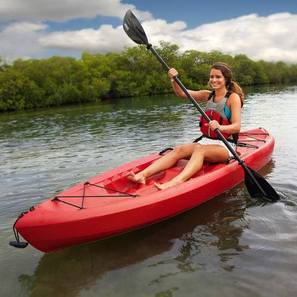
Lean Back
Rest your back comfortably on the seat - this keeps the boat stable. Your movement should come from your torso.
The Grip
With both arms comfortably in front of you take the paddle in both hands - over-handed with thumbs under. As a general guide, line up your knuckles with the upward blade edge.
Pull and Push
Each paddle stroke is a pull with your downward stroke while the upward arm pushes the paddle shaft away from you. This combined effort distributes the work. Keep your arm comfortably in front of you (like bicycling). No need to hold on too tight - you'll find the rhythm.
Leaning your arms too far forward and over extending your waist will just give you back and shoulder aches. Instead - since your torso muscles are stronger than your arm muscles, get used to using your torso to turn into the stroke - side to side. This lends more power to the stroke and saves on your arm muscles.
As you change sides the paddle shaft should comfortably rotate to line up your knuckles with the upward blade - sweeping the water to the end of the kayak.
You've reached your goal when you get these three elements all working together without thinking about it. Pull/Push - torso turning into the stroke - steadily sweeping the water. Utopia!
If you don't get this at first - keep at it - don't worry - paddling techniques are learned with repetition.
Paddling is rhythmical - it should feel like an extension of your upper body and flow without thinking about it. Once you're "not thinking about it" your whole body is relaxed and paddling is effortless - in harmony with the kayak.
Turning the Kayak
Turning your kayak is easy. You can turn by simply paddling only one side - opposite of the side you want to turn into.
You can turn quicker by placing your paddle in a vertical direction into the water on the side that you want to turn to.
Once you are headed where you want to be - resume paddling.
You can make the kayak go backwards by first slowing the kayak to almost a stop and reverse your paddling direction.
Rest your back comfortably on the seat - this keeps the boat stable. Your movement should come from your torso.
The Grip
With both arms comfortably in front of you take the paddle in both hands - over-handed with thumbs under. As a general guide, line up your knuckles with the upward blade edge.
Pull and Push
Each paddle stroke is a pull with your downward stroke while the upward arm pushes the paddle shaft away from you. This combined effort distributes the work. Keep your arm comfortably in front of you (like bicycling). No need to hold on too tight - you'll find the rhythm.
Leaning your arms too far forward and over extending your waist will just give you back and shoulder aches. Instead - since your torso muscles are stronger than your arm muscles, get used to using your torso to turn into the stroke - side to side. This lends more power to the stroke and saves on your arm muscles.
As you change sides the paddle shaft should comfortably rotate to line up your knuckles with the upward blade - sweeping the water to the end of the kayak.
You've reached your goal when you get these three elements all working together without thinking about it. Pull/Push - torso turning into the stroke - steadily sweeping the water. Utopia!
If you don't get this at first - keep at it - don't worry - paddling techniques are learned with repetition.
Paddling is rhythmical - it should feel like an extension of your upper body and flow without thinking about it. Once you're "not thinking about it" your whole body is relaxed and paddling is effortless - in harmony with the kayak.
Turning the Kayak
Turning your kayak is easy. You can turn by simply paddling only one side - opposite of the side you want to turn into.
You can turn quicker by placing your paddle in a vertical direction into the water on the side that you want to turn to.
Once you are headed where you want to be - resume paddling.
You can make the kayak go backwards by first slowing the kayak to almost a stop and reverse your paddling direction.


 RSS Feed
RSS Feed
